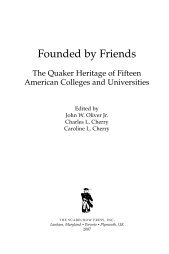Separate Realities: The Dream and the Iceberg - Scarecrow Press
Separate Realities: The Dream and the Iceberg - Scarecrow Press
Separate Realities: The Dream and the Iceberg - Scarecrow Press
Create successful ePaper yourself
Turn your PDF publications into a flip-book with our unique Google optimized e-Paper software.
90 Chapter 2<br />
of <strong>the</strong> class iceberg is also fraught with danger, though not of <strong>the</strong> physical sort.<br />
Because of <strong>the</strong> taboo nature of class, few people venture below <strong>the</strong> waterline<br />
of conventional social analysis. Down <strong>the</strong>re, visibility is limited. <strong>The</strong> images<br />
are murky. <strong>The</strong> dangers abound with miscommunication, misunderst<strong>and</strong>ing,<br />
<strong>and</strong> charges from “respectable quarters” that it is unproductive or even un-<br />
American to make <strong>the</strong> trip: better to stick with <strong>the</strong> dream than explore <strong>the</strong> iceberg.<br />
Even so, we’ll take our chances. We think <strong>the</strong> potential rewards are worth<br />
<strong>the</strong> risks, <strong>and</strong> we invite you to join us.<br />
<strong>The</strong> remainder of this book represents a tour of territory that for most Americans<br />
is familiar <strong>and</strong> yet, in many ways, unknown. Our class-power-network<br />
model serves as <strong>the</strong> basic map for exploring <strong>the</strong> hidden features of <strong>the</strong> new<br />
class society. As we will see, <strong>the</strong> dominant power networks are not abstract,<br />
ivory-tower inventions but real organizational webs of power that we encounter<br />
daily. By tracking <strong>the</strong> interests, strategies, <strong>and</strong> activities of privilegedclass-dominated<br />
organizations, <strong>the</strong> model helps us underst<strong>and</strong> how this class<br />
dominates organizations, public policies, programs, ideas, <strong>and</strong> social behavior<br />
in <strong>the</strong> economic, political, <strong>and</strong> cultural arenas.<br />
Like a magnifying glass, <strong>the</strong> model serves as a lens, bringing into focus <strong>the</strong><br />
details of <strong>the</strong> ways in which <strong>the</strong> dominant power networks have created, <strong>and</strong><br />
work to maintain <strong>and</strong> legitimate, <strong>the</strong> new class society. Using this lens, we<br />
will discover how <strong>the</strong> web of power spun by <strong>the</strong> dominant power networks<br />
attempts to control <strong>the</strong> production <strong>and</strong> enforcement of ideas about, debates<br />
over, attention to, <strong>and</strong> enactment of class-relevant laws <strong>and</strong> public policies,<br />
as well as <strong>the</strong> production <strong>and</strong> distribution of values <strong>and</strong> beliefs related to<br />
personal fulfillment, <strong>the</strong> mass consumption of goods <strong>and</strong> services, <strong>and</strong> <strong>the</strong><br />
uses of work <strong>and</strong> leisure time. <strong>The</strong> cultural dimension of <strong>the</strong> dominant<br />
power networks has become increasingly important to <strong>the</strong> legitimation<br />
process. This is <strong>the</strong> case because <strong>the</strong> cultural network includes potent organizations<br />
(e.g., <strong>the</strong> media <strong>and</strong> schools) that disseminate ideas, information,<br />
<strong>and</strong> images that help legitimate <strong>the</strong> new class system <strong>and</strong> serve as vehicles<br />
for distracting public attention away from <strong>the</strong> many inequalities of <strong>the</strong> system<br />
(as we will see in chapters 5, 6, <strong>and</strong> 7).<br />
<strong>The</strong> class-power-network model will also help us see <strong>and</strong> better underst<strong>and</strong><br />
ano<strong>the</strong>r important dimension of <strong>the</strong> class iceberg—<strong>the</strong> “underdogs” of class<br />
conflict. <strong>The</strong> alternative-power-networks portion of <strong>the</strong> model provides us with<br />
a map for underst<strong>and</strong>ing how dominant-power-network strategies, policies,<br />
programs, <strong>and</strong> ideas favoring privileged-class interests are contested <strong>and</strong> challenged<br />
in specific terms by real organizations <strong>and</strong> real people. <strong>The</strong>se challenges<br />
are grounded in an agenda emphasizing fair play, an end to arbitrary class inequalities,<br />
<strong>and</strong> greater opportunities for all Americans to actually achieve <strong>the</strong><br />
American <strong>Dream</strong> <strong>and</strong> <strong>the</strong>reby bring about a class-iceberg meltdown.
















